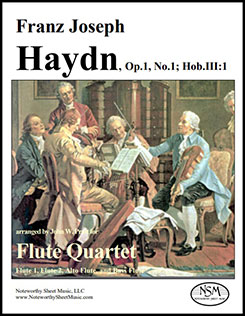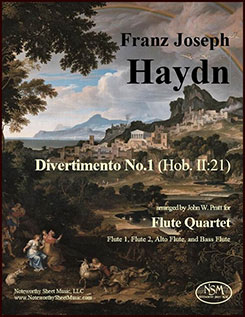Flute Duos, Trios, Quartets
- 1
- 2
Haydn - Op.1, No.1- arr. Flute Quartet
 Quartet, Op.1, No.1, by Franz Joseph Haydn
Quartet, Op.1, No.1, by Franz Joseph Haydn
Arranged for Flute Quartet by John W. Pratt (originally for strings)
Score and Parts for Flute 1, Flute 2, Alto Flute, and Bass Flute, PDF $15.99
The earliest quartets of Franz Joseph Haydn are not precursors of the later works wherein he developed the form and style of the classical string quartet, but rather divertimenti written for four friends when he was about 25. Most of these early works have five movements: fast, minuet/trio, slow, minuet/trio, fast; and their slow movements feature beautiful, elaborate, gently accompanied melodies.
The divertimento style and instrumental character of these early pieces does not evoke strings specifically or necessarily, and thus arrangement for other instruments is natural and might expand enjoyment of these wonderful first significant Haydn works to other players and audiences. In John Pratt’s arrangement of Haydn’s Op.1, No.1 (Hob.III:1), most of the range issues for flutes were solved by transposition up a step, a few more by exchanging the two inner voices in places or by octave transpositions. This lovely, effective arrangement is for a flute quartet consisting of two concert flutes, alto flute, and bass flute; the edition is available exclusively from Noteworthy Sheet Music.
Score, 19 pages; Parts for Flute 1, Flute 2, Alto Flute and Bass Flute, 5 pages each; Total, 46 pages.
PreviewHaydn – Hob. II:21 – arr. Flute Quartet
 Divertimento No. 1 (Hob. II:21; Op. 2 No. 3) by Franz Joseph Haydn
Divertimento No. 1 (Hob. II:21; Op. 2 No. 3) by Franz Joseph Haydn
Arranged for Flute Quartet by John W. Pratt (originally for string quartet plus 2 horns)
Score and Parts for Flute 1, Flute 2, Alto Flute, and Bass Flute, PDF $11.97
excerpted from John W. Pratt’s © preface to the edition:
“Haydn (1732-1809) is credited with developing the classical forms of both the string quartet and the symphony, starting from the loose structures and permissive instrumentation of Baroque instrumental music. … His first string quartets are his Opus 1 Nos. 1-4 and 6, and Opus 2 Nos. 1-6, thus eleven. Opus 1 No. 5 is somewhat later, added to make a set of 6, apparently a perfect number in music publication as well as in mathematics. Opus 2 Nos. 3 and 5 are quartet arrangements of two divertimentos including also two horns and listed in the Hoboken catalogue as II:21 and 22 … The spirit and spiritedness of the two divertimentos suit them to flute quartet, as does the distribution of activity. In addition, a flute quartet combines the unified timbre of a string quartet with the wind sound of the horns, while the early string quartets do not exploit the string sound per se. Transposition up a step puts the cello and viola parts of Hob. II:21 mostly within the bass and alto flute ranges and makes the violin parts if anything more comfortable for C flutes.”
There are 5 movements in total: I-Allegro molto, II-Minuet, III-Adagio, IV-Minuet, and V-Finale Allegro. To get some sense of how the Op. 2 No. 3 quartet works with flutes in lieu of strings, listen to this computer-generated audio clip of the first movement—realizing it will of course sound considerably better played in-person on real instruments.
Score, 11 pages; Flute 1 part, 6 pages; Flute 2 part, 6 pages; Alto Flute part, 5 pages; Bass Flute part, 5 pages; Total, 38 pages.
Preview- 1
- 2
